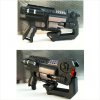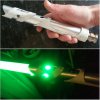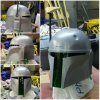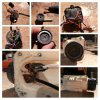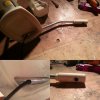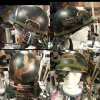Hi guys
I've recently been getting some serious interest in a replica prop project I started a while back from cosplayers and collectors alike, quite a biggie for a small time hobbyist like myself
Only trouble is, I had to put it on hold due to lack of electronics skills, every other aspect of the project I had nailed or help with (including input from the props original creator, a very rare thing in the replica game, so count myself very lucky).
Times moved on a bit and I can muddle through simple circuits and etch my own boards now, so I'm going to attempt to un-shelve the project and see how far I can get with it.
As I've learned with any new undertaking, this is probably looking bigger than it actually is, but I could do with a few pointers and suggestions to pin down some of the componants needed.
In an attempt to make it easier, I'll go through my overall plan so please bare with me if you can.
This is one of my holy grails which is why I started the project, and after having studied them at length, I'm hoping it shouldn't be too hard to identify the right ICs and componants needed to make the replica work, though there are most likely going to be some I'm unaware of that might be better suited to the task, if my ramblings bring one or two to mind, I'd be glad to hear of them
This is the prop in question. For those that don't know, it's an identity disc from the film Tron Legacy (I've been an avid Tron fan since I was a kid when the first one came out in the 80s, and I attribute it as one of the big influances for my interst in electronics)

Here's a render of the replica modelled for CNC:

There are two main light sequances and a bunch of sounds that are associated with this prop, so I'm going to need a decent ic that's up to the task of controlling both.
The first animation I need to recreate is pretty basic and concerns the C shaped light in the centre of the disc body, luckily the sequance handily lends itself to the the LEDs being arranged as parallel groups.
disc sync animation sequance, see clip@:00:34:
TRON: LEGACY - "Sirens Dress Sam" Clip:
The second animation is a bit more complex, but doable using PWM (blade animation @00:07.):
The Grid: Disc Arena HD:
).
I discovered LED driver buck ICs the other day, but it looks like they don't have PWM capability which is a shame.
Anyone know if its possible to achieve the same effect without PWM?
The ICs I've looked at so far are....
ATMEGA8A-AU. The specs seem pretty good, though it comes with a heafty 350 pages of datasheet...(erk!). A major plus is that it supports capacitance switches which I was hoping to use for the on/off function.
Handily, I've also been tentatively delving into the arduino language recently, so programing it shouldn't be too hard once I've had a bit more time to get to grips with it. There's also a lot of usefull code that's already written for most of the sensor switches I'm interested in so they should give me a good starting point when the time comes.
The other micro controller I've been looking at is the PIC16F887 which I stumbled across while ham handedly googling for appropriate ICs. I'm still going through the datasheet which says its simple to code, and it does look like it has enough oomph for the job. It must be good as this one also sports a beefy 338 pages of datasheet, but I like the coding odds being as it only needs like 30 something basic commands, I can deal with that lol.
Quick question, does anyone know if sounds can be embedded/coded into either of these chips?
If not, does anyone one know of a small multi addressable sound/play chip with a capacity of about 10-15 sec of addressable wav quality audio that might be compatible?
I see modules everywhere with some decently small chips on them, the really small ones are usually coated with some kind of black apoxy or equvilent (probably a bit lo-fi for my needs though), but I'll be damned if I can find any of the ICs on their own.
So far I have an ISD2540 which fits the above description, however, it's in a PDIP package and is somewhat large. Not sure its going to work with the PCB design plan I'm aiming for, so I'm looking for an alternative
Also, it seems that while my back was turned, the ISD25xx family were discontinued, so not sure I'll be able to get the smaller MSOP versions now, if I do they're likely to be somewhat expensive, and they weren't cheap to start with.
Now, since I need to control some 200+ LEDs in a matrix, stuffing enough power onto one PCB in such a tight space was looking like a major a problem. The prop guys solved this by giving each LED it's own button cell, but the disc didnt stay lit for long before a recharge was needed. Fine for filming perposes, but not as a display item or costume prop where longer durations of "on" time are wanted/needed.
After giving it some serious thought, I hit on the idea of splitting the PCB into sections and making it modular rather than go for a solid ring. One as the master, with the remainder being slaved (4 or 8 sections in total making a full ring).
Also, if each one has its own power supply and charging capabilty during the charging, it solves the problem of supplying enough juice to the LEDs since each section has a lot less of them to deal with in the first place.
I'm given to understand there's some pretty small lithium batteries for PCBs that could be used in this case, anyone have a lead on those?
Splitting up the PCB also means that only two, maybe three small boards need to be designed rather than one big one depending on what will fit. It would also make repairs down the line simple too as it'll be possible to hot swap sections out should a one of them stop working.
I will of course need to find a way to link the boards up, though possibly using right angle headers will be ok as the disc shell and other parts have been specifically designed to firmly hold and protect the PCB within.
The plan for the C ring and blade is to make them from a medium firm rubber to allow the light to pass while acting as an impact/vibration absorbers.

If anyone fancies making the gerber files for this once I've sorted out the component side of things, please drop me a PM. I have no experiance with PCB CAD yet, bar a phone app for tonor transfer which doesnt really count lol.
I've recently been getting some serious interest in a replica prop project I started a while back from cosplayers and collectors alike, quite a biggie for a small time hobbyist like myself
Only trouble is, I had to put it on hold due to lack of electronics skills, every other aspect of the project I had nailed or help with (including input from the props original creator, a very rare thing in the replica game, so count myself very lucky).
Times moved on a bit and I can muddle through simple circuits and etch my own boards now, so I'm going to attempt to un-shelve the project and see how far I can get with it.
As I've learned with any new undertaking, this is probably looking bigger than it actually is, but I could do with a few pointers and suggestions to pin down some of the componants needed.
In an attempt to make it easier, I'll go through my overall plan so please bare with me if you can.
This is one of my holy grails which is why I started the project, and after having studied them at length, I'm hoping it shouldn't be too hard to identify the right ICs and componants needed to make the replica work, though there are most likely going to be some I'm unaware of that might be better suited to the task, if my ramblings bring one or two to mind, I'd be glad to hear of them
This is the prop in question. For those that don't know, it's an identity disc from the film Tron Legacy (I've been an avid Tron fan since I was a kid when the first one came out in the 80s, and I attribute it as one of the big influances for my interst in electronics)

Here's a render of the replica modelled for CNC:

There are two main light sequances and a bunch of sounds that are associated with this prop, so I'm going to need a decent ic that's up to the task of controlling both.
The first animation I need to recreate is pretty basic and concerns the C shaped light in the centre of the disc body, luckily the sequance handily lends itself to the the LEDs being arranged as parallel groups.
disc sync animation sequance, see clip@:00:34:
TRON: LEGACY - "Sirens Dress Sam" Clip:
The second animation is a bit more complex, but doable using PWM (blade animation @00:07.):
The Grid: Disc Arena HD:
I discovered LED driver buck ICs the other day, but it looks like they don't have PWM capability which is a shame.
Anyone know if its possible to achieve the same effect without PWM?
The ICs I've looked at so far are....
ATMEGA8A-AU. The specs seem pretty good, though it comes with a heafty 350 pages of datasheet...(erk!). A major plus is that it supports capacitance switches which I was hoping to use for the on/off function.
Handily, I've also been tentatively delving into the arduino language recently, so programing it shouldn't be too hard once I've had a bit more time to get to grips with it. There's also a lot of usefull code that's already written for most of the sensor switches I'm interested in so they should give me a good starting point when the time comes.
The other micro controller I've been looking at is the PIC16F887 which I stumbled across while ham handedly googling for appropriate ICs. I'm still going through the datasheet which says its simple to code, and it does look like it has enough oomph for the job. It must be good as this one also sports a beefy 338 pages of datasheet, but I like the coding odds being as it only needs like 30 something basic commands, I can deal with that lol.
Quick question, does anyone know if sounds can be embedded/coded into either of these chips?
If not, does anyone one know of a small multi addressable sound/play chip with a capacity of about 10-15 sec of addressable wav quality audio that might be compatible?
I see modules everywhere with some decently small chips on them, the really small ones are usually coated with some kind of black apoxy or equvilent (probably a bit lo-fi for my needs though), but I'll be damned if I can find any of the ICs on their own.
So far I have an ISD2540 which fits the above description, however, it's in a PDIP package and is somewhat large. Not sure its going to work with the PCB design plan I'm aiming for, so I'm looking for an alternative
Also, it seems that while my back was turned, the ISD25xx family were discontinued, so not sure I'll be able to get the smaller MSOP versions now, if I do they're likely to be somewhat expensive, and they weren't cheap to start with.
Now, since I need to control some 200+ LEDs in a matrix, stuffing enough power onto one PCB in such a tight space was looking like a major a problem. The prop guys solved this by giving each LED it's own button cell, but the disc didnt stay lit for long before a recharge was needed. Fine for filming perposes, but not as a display item or costume prop where longer durations of "on" time are wanted/needed.
After giving it some serious thought, I hit on the idea of splitting the PCB into sections and making it modular rather than go for a solid ring. One as the master, with the remainder being slaved (4 or 8 sections in total making a full ring).
Also, if each one has its own power supply and charging capabilty during the charging, it solves the problem of supplying enough juice to the LEDs since each section has a lot less of them to deal with in the first place.
I'm given to understand there's some pretty small lithium batteries for PCBs that could be used in this case, anyone have a lead on those?
Splitting up the PCB also means that only two, maybe three small boards need to be designed rather than one big one depending on what will fit. It would also make repairs down the line simple too as it'll be possible to hot swap sections out should a one of them stop working.
I will of course need to find a way to link the boards up, though possibly using right angle headers will be ok as the disc shell and other parts have been specifically designed to firmly hold and protect the PCB within.
The plan for the C ring and blade is to make them from a medium firm rubber to allow the light to pass while acting as an impact/vibration absorbers.

If anyone fancies making the gerber files for this once I've sorted out the component side of things, please drop me a PM. I have no experiance with PCB CAD yet, bar a phone app for tonor transfer which doesnt really count lol.


